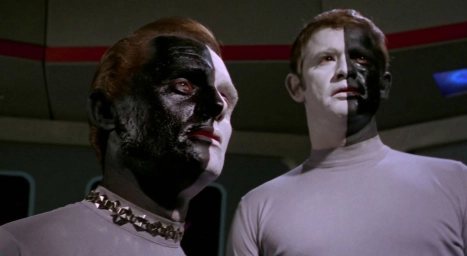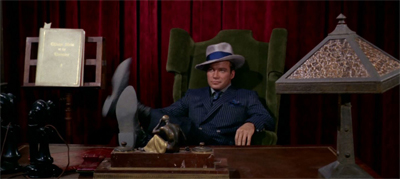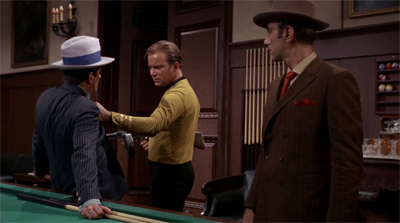This July and August, we’re celebrating the release of Star Trek Beyond by taking a look back at the third season of the original Star Trek. Check back every Monday, Wednesday and Friday for the latest update.
Star Trek is dead.
Not in a literal or technical sense. The show had been brought back from the brink of cancellation, offered a last-minute reprieve by NBC following a number high-profile fan campaigns. As far as outside observers were concerned, Star Trek lived. Kirk and Spock would continue their voyages into the space, the production team offering new and exciting interstellar adventures for the delectation of the audience at home. The execution had been stayed, Star Trek was back on television for another season.

End of the line.
However, the show had been mortally wounded. Star Trek was clearly not a top priority for NBC. The show was moved to the infamous “graveyard slot” of Fridays at 10pm. The budget was slashed even further. Most of the top tier creative talent left, including veteran producers Dorothy Fontana and Gene L. Coon along with creator Gene Roddenberry. Tensions were simmering behind the scenes. Even before NBC cut the season order to twenty-four episodes later in the season, it was clear that the series was on its last legs.
Star Trek was very much in limbo. Indeed, looking at third season as a whole, many such analogies suggest themselves. Star Trek was a show limping and lurching towards its own funeral, hobbled and humbled by forced outside of its control. These creative problems bubbled through the production into the finished product, with much of the third season inheriting a haggard and defeated disposition. There is a funereal tone to a lot of the third season, distinct even from the Lovecraftian horror that bubbled through the show’s earliest episodes.

The brains of the operation…
Spectre of the Gun is part of that funereal tone, although it is also something different. Spectre of the Gun was the first episode of the season to be produced, although it was shuffled into the sixth broadcast slot. To be fair, this rescheduling seems appropriate; Spectre of the Gun aired both the week of Halloween and one day shy of the eighty-seventh anniversary of the gunfight at the O.K. Corral. The episode has a haunted quality to it, a more mournful horror than that on display in the franchise’s previous “Halloween episode”, Catspaw.
In some ways, there is an interesting contrast between the first episode of the third season to be produced and the first episode of the third season to air. Both Spectre of the Gun and Spock’s Brain speak to the grim realities of the third season, offering a taste of the anxieties simmering through the show. Both seem to acknowledge that Star Trek is a shell of its former self, whether in the half-remembered ghost town of Spectre of the Gun or the brainless Spock shuffling his way through Spock’s Brain. The only difference is that Spectre of the Gun is a good episode.

Men of mist-ery.
Death stalks through Spectre of the Gun. Seeking to confront the Melkotians, Kirk and his crew beam down to a formless world that is nothing more than swirling clouds of gas. When they find themselves transported to Tombstone, the sky is an ominous red and the Earps are cast as horsemen of the apocalypse. The world seems hollow; the sound stage is incomplete. Time ticks down, albeit to a fictional five o’clock deadline rather than the historical three o’clock shout out. During the final confrontation, the wind howls as if the world itself is screaming in anguish.
Spectre of the Gun confronts Kirk with a world of phantoms. It evokes a world long vanished into fading memory, populated by characters who died long before. It traps Kirk and his crew in what is effectively a death trap, cutting off all of their narrative options as it marches them inexorably towards a bloody finale. It is even written by a ghost, with Lee Cronin a convenient fiction allowing former producer Gene L. Coon the chance to write a few scripts for a show he had already departed and which was not long for this world. The setting is even called “Tombstone.”

Even the newspaper is in on it!
Continue reading →
Filed under: The Original Series | Tagged: criticism, fred freiberger, Gene L. Coon, postmodernism, spectre of the gun, star trek, westerns | 16 Comments »











































Star Trek – Bread and Circuses (Review)
The first Star Trek pilot, The Cage, was produced in 1964. To celebrate its fiftieth anniversary, this December we are reviewing the second season of the original Star Trek show. You can check out our first season reviews here. Check back daily for the latest review.
Bread and Circuses is not subtle. Then again, that is the point.
There’s a lot of interesting stuff happening in Bread and Circuses, the fourteenth episode produced for the second season, but the last to air. There’s the idea of a world dominated by “a twentieth century Rome”, a rogue captain, a Prime Directive dilemma and a scathing indictment of modern television. Not only is it one of the last episodes with a “produced by Gene L. Coon” credit, it is also an episode co-written by Roddenberry and Coon. It is also the episode of Star Trek that endorses Christianity most explicitly and heavily.
“Wait, we’re only getting it in black and white?”
Bread and Circuses is a bold and audacious piece of television, full of venom and righteous anger, rich in satire and cynicism. It’s a plot so ridiculously over-stuffed with good ideas that viewers are liable to forgive the show’s somewhat cop-out ending where Kirk and his away team beam back to the Enterprise and continue on their merry way as though little has actually happened. Bread and Circuses feels like it uses every minute of its fifty-minute runtime wisely, balancing character with world-building.
It is probably a little bit too messy and disjointed to be labelled a dyed-in-the-wool classic, particularly when compared to the shows produced around it. Nevertheless, it is a decidedly ambitious piece of work, and one that demonstrates what Star Trek could do when it sets its mind to something.
When in Rome…
Continue reading →
Filed under: The Original Series | Tagged: behind the scenes, cancellation, capitalism, Christ, christianity, competition, culture, faith, fans, fourth wall, game shows, Gene L. Coon, gene roddenberry, kirk, McCoy, ralph senensky, reality television, religion, romans, romulans, science fiction, Shatner, social commentary, space!romans, spock, star trek, star trek: the original series, Television, the all, the original series, tos | 6 Comments »